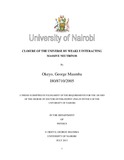| dc.description.abstract | The role of neutrino mass in the context of grand unified theory has been investigated using the
equilibrium condition between a critically expanding universe and weak neutrino interaction rates
in the early universe. The critical expansion rate has been studied using the Friedman equation
that was modified by expressing the scale factor as a function of time. This gave rise to the model
equation used in the investigation to establish the critical nature of the expanding universe. The
delicate equilibrium balance between expansion and weak neutrino reaction rates generated the
Boltzmann transport equation; this was solved by Successive Approximation technique and a
mass value of 1.57 GeV was established for heavy or non-relativistic neutrino. For a light or
relativistic neutrino, a mass value of 1.97 eV was determined. The results were found to generate
a cosmological mass gap for neutrino masses in the range between 1.97 eV and 1.57 GeV as
opposed to the standard electroweak model of particle physics that allows existence of a massless
neutrino. More importantly, the presence of a GeV neutrino mass predicts existence of a fourth
family of leptons. When the calculated mass was used in the calculated See-Saw relation, a
unification scale of 13 10 542 .1 GeV was achieved. This energy scale is interesting since the
weak, electromagnetic and strong interactions would all have the same strength at around 1013
GeV-1016 GeV which suggests a very similar value for the grand unification scale. This appears
promising as the anticipated discovery of tiny neutrino masses may help in probing the structure
of the particle physics models that lie beyond the standard electroweak model.
Neutrino mass generation has also been investigated using the standard Higgs mechanism
technique. The standard electroweak Lagrangian was modified by adding a mass term to it and a
perturbation to the vacuum expectation value generated neutrino mass term couplings. This was
found to be true with the aid of scalar fields, which, in this case was the Higgs boson. Also from
the theory of neutrino oscillations, it was found that neutrinos of different masses travel with
different velocities rather than with the same velocity. In particular, the dynamical effect i.e. the
probability of neutrino oscillation was found to be very dependent on neutrino mass. This was
studied by using the simple approach of mathematical theory of matrices rather than the
complicated methods of renormalization. The results anticipate that the oscillation experiments
(such as Fermilab’s LBNE and the MINOS) may play an important role in putting the evidence
for neutrino mass on a more solid and practical evidence. | en |

